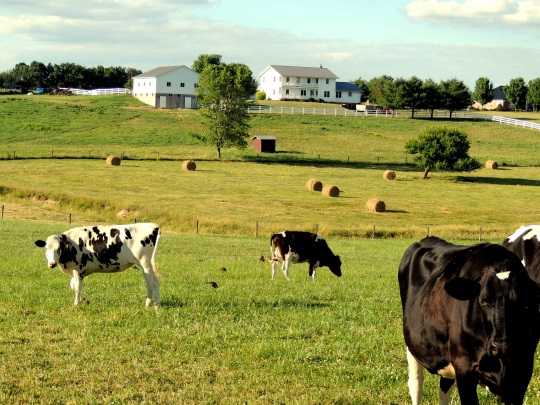Measuring Amish Wealth and “Poverty”
Do “classes” exist in Amish society? How is wealth distributed? Do Amish use food stamps?
A new study in the latest JAPAS addresses these questions in the Holmes County Amish community (“Amish Economic Transformations: New Forms of Income and Wealth Distribution in a Traditionally “Flat” Community“, by Amyaz Moledina, David McConnell, Stephanie Sugars, and Bailey Connor).

By tapping public data including Census info and real estate records, the authors develop a picture of Amish income and wealth in a segment of the Holmes settlement.
Using data for one heavily-Amish Census Tract, land title information, and the local church directory, they plot distributions of income and real estate holdings (land is described as “an excellent indicator of accumulated wealth”).
They also provide specific numbers for each of the four major Holmes County Amish groups (Old Order, Andy Weaver, Swartzentruber, New Order).
Interesting Findings
The paper contains a number of interesting findings about Amish in the Census Tract studied, including:
- Higher rates of poverty than the national norm
The study’s findings “suggest that a disproportionately large number of Amish individuals in Census Tract 9763.01 have incomes below national poverty levels”. The authors note that this may be misleading, given differences in cost of living, larger families, and reliance on barter and sharing typical among Amish.
In 2006, local agencies in Ohio were tasked with boosting low food stamp participation rates in the state’s heavily-Amish counties. Likewise, the paper’s authors find that Amish food stamp participation in the area studied is basically nil (though a small number of Amish likely collect Social Security benefits).
- Swartzentruber Amish own more land
They actually own a lot more on average than any of the other three groups–over twice as much acreage per person. The distribution of acreage is also most uniform among Swartzentrubers. These findings support the idea that Swartzentruber Amish have maintained an agricultural lifestyle more than other affiliations.
- Bishops are more land-wealthy
The study also looks at land holdings by position in the ministry. The authors found that “as church rank increased from member to bishop, the distribution seemed to skew to the right, bishops having the highest total land values, suggesting church rank is associated with higher land wealth.”
The paper doesn’t address why this might be, but in concluding remarks the authors suggest further questions. Are church members more apt to nominate ministry candidates who own a lot of land? Do differences emerge after candidates are ordained?
If you found this interesting, you’ll probably enjoy reading the article in full.







Fascinating research
Fascinating stuff, Erik! Thank you for the research you do and keeping us informed about the social and economic pressures that affect the Amish and how they respond. Your articles are always thought provoking.
Interesting
One would believe that ‘poverty’ would be common among Amish peoples. Like the articles suggests, though, can’t the information be scewed? Our life of television-TV dinners-got to get a New LaZboy-refinanced so we now have only five credit cards is, well, WHOA NELLIE!, compared to lifestyle of God-house-home-land or business-and family.
By the way, come visit my new blog! Still undergoing construction, but the main page is stable.
KJV Conservative/ Ada
Almost forgot
The address for my blog is plainpathwaytohim.WordPress.com.
Blessings,
KJV/Ada
I clicked on the link in this article to the story about the Ohio Food Stamp Office being required to “boost participation” among the Amish, and was appalled beyond words. However, I note that it was a 2006 story, so I’m wondering if Erik can give us an update. Have the Food Stamp folks, however well-intentioned, finally gotten a clue about the Amish and other self-reliant , resourceful, and community-minded people?
Amish and Food Stamps
I remembered the Amish food stamp story because I actually posted about it in the early days of this blog 🙂
I don’t recall ever seeing a follow-up, and haven’t been able to find anything besides the initial reports like the one I linked. I guess you could consider this paper a follow-up.
What struck me about the original story was how the better-informed local agents seemed to know their efforts would be wasted…but that their higher-up of course knew better 😉
Yes, Erik, that struck me too – the local guys knew it was silly.
Church Land
My first thought also was the part about the Bishops, as to which came first wealth or position, does land accumulation make a better Bishop or vice versa ? Also there does not appear to be any land held in common by “The Church”. Unlike most religions that have A church with, of course, tax exempt status. Also do the Amish have their own cemeteries ?
Amish leaders' land onership
Owning a lot of acres would be associated with traditional dairy farming and even with the move towards business, farming is still broadly seen as the ideal occupation among the Amish, at least in terms of raising a family.
Amish men may be seen as better candidates for minister and bishop positions if they model this traditional agricultural way of living. However with many congregations having high concentrations of businesses this perception may be changing. There are quite a few business-owning bishops and ministers.
Maybe church members generally nominate landowner/farmer individuals more often because of a bias towards having traditional farmers in the ministry. Or maybe members of the ministry later gravitate towards farming as a way of modeling the “classic” Amish family farm lifestyle and thus in their minds being a “better” minister or bishop. Or maybe there is something else going on? It’s an interesting finding.
Wealth versus Amish position
Whether an Amish man is wealthy or not has nothing to do with him being selected for preacher or Bishop. Any Church member can put forth a church members name as a camdidate for Bishop, and that would then make the group. If there is not a Bishop in the church group yet, the preachers already selected go to a closed room, prepare the number of bibles as the number of candidates for Bishop and then put a single piece of paper in one of the Bibles. The bibles are then lined up on a table before the church group and the eldest candidate then selects a bible and sets down. Each candidate in descending age then does the same. The eldest candidate then opens his bible and shows whether he has the bible with the paper in it. If he does not it goes on to the next man until the bible with the paper in it is revealed. That man then becomes,Bishop. It is done in this manner, the Amish believing that God is the ome that has selected the Bishop. He becomes the Bishop for that Church Group for life.
having been amish the first 30 years of my life, I do know that the amish are able to live well below poverty and still able to raise a family and save money. they dont have the monthly electric,car insurance, and the health insurance (is cheaper) to name a few. their are some amish families that accept the food stamps when needed, but most never apply for it. the cemeteries are located throughout the communities and shared by families and neighbors, in the summer they are maintained often times by land owner or families of the deceased.
Amish accepting food stamps
That’s interesting Naomi, as far as some accepting food stamps when needed, do you know in which settlement(s) or church affiliation(s) that might be happening?
According to the article the entire Census Tract is likely about 80% Amish, but food stamp participation is only 1.6%, so theoretically there may be a few Amish in that mix getting food aid. Within a smaller subdivision of that Tract, food stamp rates go to 0%.
I’d expect gardens, canning, the family cow and butchering home-raised animals probably fill a lot of food gaps though some do have very low incomes and a lot of mouths to feed.
Erick/Naomi-
That would remind me of the English-converted-to-Amish gentleman that was addressed on Amish America a little while back. Wasn’t he also having financial troubles?
Speaking of such, has his and his wife’s financial situation improved? I remember that their were a few people willing to buy baked sweets from her business to help.
Anyhow, I wonder if any food banks allow Amish people. I ask this because, when I worked at a church-owned food bank, several utility bills, etc. And a photo ID were required, unless it was an absolute emergency (then we fudged the rules…). Also, you had to be on welfare to legally get anything from the foodbank. Then again, we have a lot of illegal aliens in Florida.
Again, off the hand, but are photo IDs required for buggy-operators? I know, it’s a laughable question, but I am serious (and ignorant on such matters).
Amish food aid
KJV, you might mean Ed, whose mother Anne shares here from time to time? I haven’t heard much lately, though I imagine getting through the harsh Minnesota winter won’t hurt. Maybe Anne will catch us up at some point.
https://amishamerica.com/when-a-son-joins-the-amish/
https://amishamerica.com/when-a-son-joins-the-amish-hard-times/
https://amishamerica.com/when-a-son-joins-the-amish-dollars-degrees-dentists/
As far as food banks, I just don’t see many instances when Amish would end up in that situation, but I suppose it’s theoretically possible. “The Amish” often surprise me, but I could more easily see Amish accepting Social Security or unemployment benefits than food aid.
I Wouldn't Know
Thanks for the information, Erik! I wouldn’t really know because, being geographically (?) isolated from any Plain religion, I get what little information I have from the Web (most of which can hardly pass for trustworthy, accurate, or unbiased…). Shortly, I find it safer to ask from here.
Yes, that sounds like him! When I fist posted, I was almost going to say “Mark’s son,” but I didn’t want to say something like that, and it turn out that he did not have a son…
KJV/Ada
It's all relative ...
This reminds me of the situation I am familiar with, and have shared with Erik & on this site, of an Amish community that outwardly appears to be destitute … yet was trying to do a cash deal of some nearly 3/4 of a million dollars for some property adjoining their community. The only reason the deal fell through was that the family selling the property started squabbling among themselves at the close and some of them walked out, refusing to participate.
While that was a deal killer, but for that issue these Amish people that live in a community that looks as if none of them could rub two thin dimes together were going to plunk down over $700,000 CASH MONEY for the purchase. I know a bunch of people that most folks would consider to be “wealthy” by general standards; owners of nice homes, nice cars, boats, vacation homes etc. but who couldn’t even consider doing something like that. I know that I couldn’t for sure.
Never judge a book by its cover …
While I enjoy learning more about the Amish on this blog, I also end up with exponentially more questions with each posting! I feel like KJV/Ada, wanting to know more (though I wonder if my own questions seem laughable).
I found the part about Bishops more likely to own more land to be interesting, too—sort of a “chicken or egg” query.
All in all, like my namesake, I find myself “curiouser and curiouser” the older I get! 🙂
Alice Mary
Questions are always good Alice Mary, just glad I have help here answering them 🙂
Also am glad for the feedback that people enjoyed this, I hope it encourages reading JAPAS. Since this got a nice response I might share more on another of the articles in the latest issue.
Well Alice Mary, if You Want to Know...
Answer:
The chicken came first.
(Just a joke! 🙂 )
Ada
(P.S: Come visit my new blog, plainpathwaytohim.wordpress.com, if you have not already done so. Since I do not use Facebook, etc., I include my invitations on my comments.)
Very interesting article and thoughts on this topic. Thanks, Erik and community.
Ramen Noodle and Poverty
Small economies and businesses that rely on communal structures have had a difficult time in the US but makes for excellent startups. Eventually, when developing more individual businesses they can tap the larger economy. A case in point is the ramen noodle restaurant, that currently is larger in size than McDonalds and growing. But who knows this? Not very many because it is a mini economy tapping into the larger economy.
I don’t know about a chain, but there is a Ramen restaurant in my community.
That’s good stuff though, Raman.
I like to make a nice spaghetti using either the store brand or “Mr. Noodles” brand of that sort of noodle usually done as soup.
Hi Robert,
Where are you finding this ramen noodle restaurant information that says they are bigger than McDonalds? On the surface that doesn’t sound right at all unless you mean some specific part of it.
Here is a what I am looking at:
http://www.therichest.com/rich-list/most-popular/the-top-10-biggest-chain-of-fast-food-restaurants-in-the-world/
Tom in Lincoln LincNebr@hotmail.com
Thanks for the info !
Erik, Naomi, et al, thanks for sharing your knowledge about the Amish. I, like most of the rest of you, the more I know, the more curious I am. And NO Alice Mary, I don’t think any of your questions are laughable !
More Ramen Info.
Ramen noodles, a great market item, that used to come in those little paper boxes I could add hot water and wow! If that’s the ramen you know and the only one you know, or you think its coming on a restaurant menu, then I’m here to inform otherwise. I’m talking about ramen restaurants run by chefs that have at least a dozen different ramen noodles on the menu. These places are small and yes they out number McDonalds. NJ is the HQ for ramen but probably unknown because they operate low level their factory is swinging busy. Once the almost sole purview of the Pennsylvania Dutch egg noodle this NJ-Pa geo area is turning to a total meal served by a ramen gourmet chef for less than $5-7. In the US there are only 60,000 ramen restaurants not counting Asia where its estimated to be 10x more.
Link
http://sunnoodle.com/
I looked at the site…the FAQ and it says:
Are you a restaurant?
No, we are not a restaurant, rather, suppliers to restaurants.
So, where does this company (the restaurant chain) outnumber McDonalds? In one town/state?
You have McDonalds (34,000+) every few miles in most cities. I don’t see any other restaurant like you are talking about like that.
What am I missing?
Hmmm....
Ramen Noodle: The New Mystery of the World and to Mr. Groszfeelich.
Ada (:) )
Missing?
Unconventional wisdom from yoga master say…watch the videos and visit Chinatown & eat at a ramen noodle place.
Mark's take on the Amish wealth issue
I asked my son, Mark, about Amish wealth and its relationship to church leadership. He said that he feels that is inaccurate to relate land to wealth. It depends on whether the land is paid off or not. But he does say that there is definitely a correlation between farming as an occupation and church leadership. Mark feels that deep in the Amish culture is an abiding desire to farm and a respect for those Amish who make the sacrifice to do so. Also, Mark has found that most of the Amish dairy farmers tend to be more conservative in outlook. This conservativeness as regards the ordnung and such is also respected among most Amish. Of the three bishops in Mark’s community, two are relatively young dairy farmers. The other is a young man who works in his father’s cabinet shop. But Mark says he would not say that any of the three young bishops are wealthy. They all have considerable debt to repay. Does this make them wealthy? Mark says that of the carpenter crews in the community most of the men working on the crews are earning a living until they can start their own home business. Most Amish, in Mark’s opinion, would definitely prefer to work at home and will sacrifice income so as to do so.
Very interesting article, Erik. Having been a stats guy myself, I’m regularly reminded that even though stats don’t lie, liars still use stats (i.e., be sure the stats really do say what the person is telling you that they say). (ha)
I’m struck with the statement that, “They [Swartzentrubers] actually own a lot more [land] on average than any of the other three groups–over twice as much acreage per person.” While I accept it on face value, I still wonder if there are factors that come into play that misrepresent the whole truth on this. I’m assuming that “per person” includes all people regardless of age. This could be skewed by any difference in average-family-size between the Swartzes (as I’ve heard some other Amish call them) and other Amish groups. Or, if the Swartzes are (for example) dwindling in population overall, or if the younger generation has been prone to go to another group — these are factors that could make distribution appear to be more out of balance than it really is. But that being said, I’m sure that their greater commitment to live on and work the land probably does have a legitimate impact on the findings.